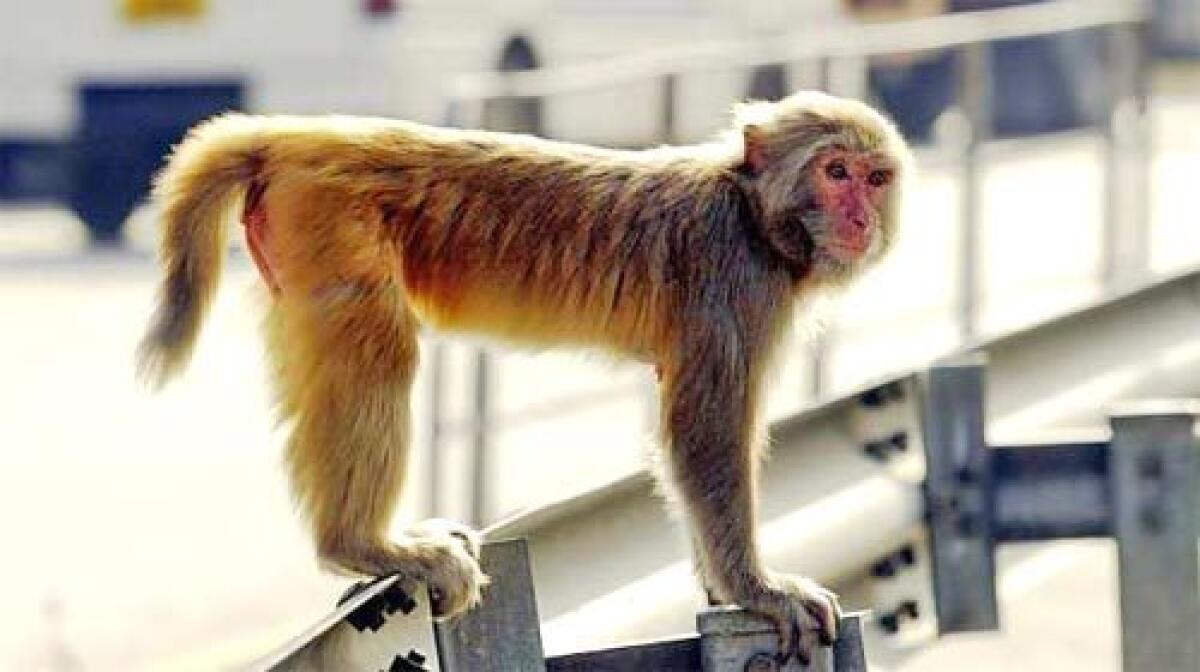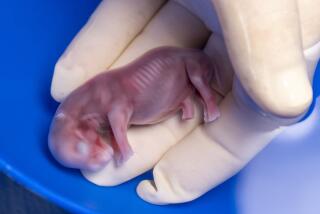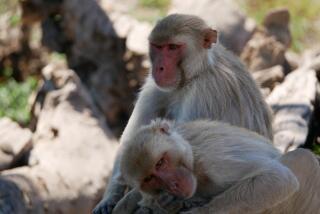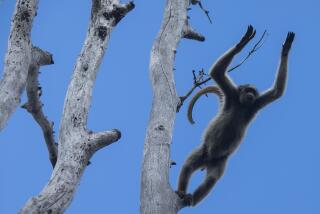Monkey embryos cloned for stem cells, scientists say

After years of false starts and an international scientific scandal, researchers said Wednesday that they had achieved a feat that some scientists believed was impossible -- cloning a monkey embryo from a skin cell of an adult and using it to harvest embryonic stem cells.
Scientists have previously cloned embryos and adult animals of a variety of species, including rats, dogs and cattle. But primates -- the family that includes monkeys and humans -- have proved remarkably resistant to the most sophisticated techniques in the cloner’s arsenal.
Reproductive biologist Shoukhrat Mitalipov of Oregon Health & Science University and his colleagues reported in the online version of the journal Nature that they had successfully cloned rhesus macaque embryos using DNA from skin cells taken from the ear of a 9-year-old male. The resulting stem cells grew into viable heart and nerve cells, among others.
“This is a giant step toward showing that human therapeutic cloning is possible,” said Dr. Robert Lanza, an embryonic stem cell researcher at Advanced Cell Technology in Worcester, Mass., who was not involved in the research. “It proves once and for all that primate cloning is not impossible . . . as many people had thought.”
Work has already begun to use the new technique to clone human embryos, although the process is still inefficient. Even so, Mitalipov said, “I am quite sure that it will work in humans.”
The technical feat is a breakthrough in efforts to clone human embryos to create stem cell lines that are genetically matched to sick patients so the cells will not run the risk of rejection.
Although clinical applications of the technology are years away, some preliminary studies suggest that the stem cells, which have the potential to grow into any type of cell in the body, could be used to treat a range of diseases, including Parkinson’s, Alzheimer’s and diabetes.
Cloning pioneer Ian Wilmut, who led the team that created Dolly the sheep more than a decade ago, said that in the more immediate future, Mitalipov’s technique could be used to produce monkeys with diseases that more closely mimic human ailments. That would lead to a better understanding of disease processes and the identification of new drugs to treat them, Wilmut and Jane Taylor of the University of Edinburgh wrote in an editorial accompanying the paper.
Mitalipov said his lab was already working toward those goals, particularly for Type 1 diabetes.
Many scientists hailed the achievement, but Father Thomas Berg, executive director of the Westchester Institute, a Roman Catholic ethics think tank, called it “a two-edged sword.” He praised the possibility of gaining a better understanding of the disease process in primates, but said applying the technology to humans “would be one of humanity’s darkest endeavors.”
Social conservatives object to human embryonic stem cell research because it involves the destruction of embryos. President Bush has restricted federal funding for such research.
Creating stem cells through therapeutic cloning is particularly controversial because the technology could theoretically lead to the birth of a cloned baby. None of the researchers said they were planning to clone children.
The team of researchers, from Oregon and the University of Nebraska Medical Center, used a technique called somatic cell nuclear transfer, in which genetic material from a somatic cell -- any cell other than a sperm or egg -- is transferred into the nucleus of an unfertilized egg.
The problem is that the DNA from the donor is not at the same stage of life as the material in the egg, and getting the two into rhythm can be difficult.
The process has been likened to a ballroom dance in which one partner starts on the beat while the second starts on the off-beat, destroying the rhythmic flow.
Each species studied has required its own set of technical modifications to coax the two cellular constituents into step.
In many species, for example, researchers use dyes to see the part of the cell that holds the DNA in place. Mitalipov concluded that the stains were impeding the cloning process in primates and developed a technique using polarized light that avoided the problem.
They also discovered a variety of other technical tricks, including removing calcium and magnesium from the medium in which the cells were grown.
They transferred the entire skin cell into an egg from which the nucleus had been removed. “The egg within two days was able to reprogram the somatic cell into an early embryonic stem cell,” he said.
This study is “really a combination of refinements of technologies that results in a better end result,” said Paul J. Simmons, director of the Center for Stem Cell Biology at the University of Texas Health Science Center in Houston, who was not involved in the research.
Even with all the modifications, the team was able to produce only two stem cell lines from 304 eggs subjected to the process, a success rate of 0.7%. One of those lines had an abnormal Y chromosome; the other was normal.
Other scientists were not particularly concerned with the inefficiency, however. When any technology is first developed, “it will be inefficient and not terribly practical,” said molecular biologist Larry Goldstein of UC San Diego, who was not involved in the research. “The first computer was pretty slow. . . . You have to keep it in perspective.”
The team did not attempt to use the embryos to produce baby monkeys by implanting them in surrogate mothers, Mitalipov said.
James Byrne, lead author of the study, moved from Oregon Health & Science University to Stanford University over the summer and is now trying to replicate the work using human eggs and cells, said Renee Reijo Pera, director of human embryonic stem cell research at the Stanford Institute for Stem Cell Biology and Regenerative Medicine.
She noted that one of the major impediments to the research is obtaining an adequate supply of human eggs. “Availability will always be a major problem,” she said.
The report is not the first to claim success at cloning a primate embryo. Korean researcher Hwang Woo-suk published two papers in the journal Science in 2004 and 2005 saying that he had cloned a human embryo.
The papers were later withdrawn after Hwang was accused of fabricating data, and other researchers were unable to replicate his results. Hwang lost his position at Seoul National University and faces criminal charges for fraud and misuse of research funds.
The editors of Nature took the highly unusual step of submitting biological samples from Mitalipov’s lab to Australian researchers for confirmation.
Geneticist David Cram and his colleagues at Monash University analyzed DNA from the male macaque who served as a skin cell donor, the two females who donated the eggs and the stem cells themselves.
They concluded that “beyond any doubt” the stem cells came from cloned embryos.
More to Read
Sign up for Essential California
The most important California stories and recommendations in your inbox every morning.
You may occasionally receive promotional content from the Los Angeles Times.











